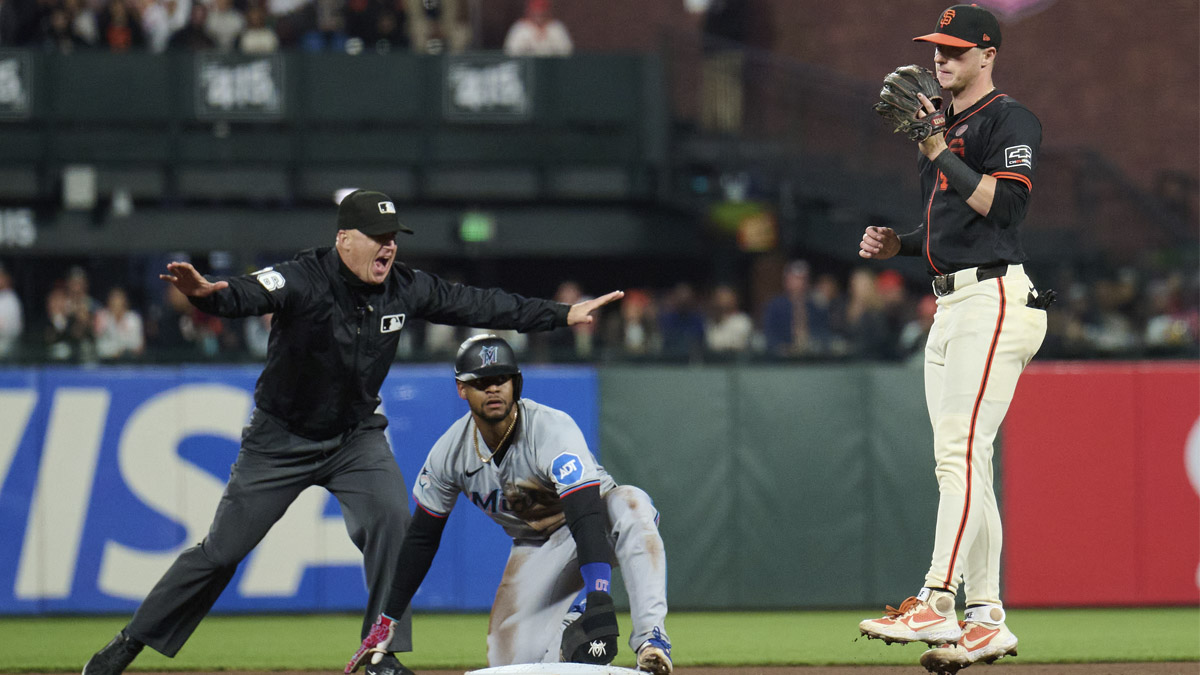
Giants irate over ‘terrible’ obstruction call in loss to Marlins originally appeared on NBC Sports Bay Area
SAN FRANCISCO – In the aftermath of a frustrating one-run loss to the Miami Marlins on Saturday, the Giants were bitter over a controversial call that led to the deciding run being scored.
The play happened in the seventh inning when Miami’s Otto Lopez drew a leadoff walk then stole second base. Giants catcher Patrick Bailey threw down to shortstop Tyler Fitzgerald, who appeared to make the tag before second base umpire Ryan Blakney signaled safe because Fitzgerald apparently had obstructed the runner.
Giants manager Bob Melvin asked for umpires to take a second look at the play, and after a brief meeting between the four, the original safe call was upheld.
“They called it obstruction, and I don’t know how that affects the play,” Melvin said after the Giants’ 4-3 loss. “I mean, [Lopez is] sliding to the back part of the bag. Yeah [Fitzgerald’s] foot’s in front of part of the bag but when when he was sliding to the back of the bag, you’re trying to make a tag and it doesn’t affect the play. I don’t know how you can make that call. There should be some feel involved with that, is what I was told.”
Major League Baseball instructed umpires to be more diligent this season about obstruction plays, particularly those at second and third base.
That was emphasized to all 30 teams during spring training, although there weren’t many instances of the rule coming into play then.
It has happened with more frequency lately, and Fitzgerald is the latest infielder to get caught up in the mess.
“I thought it was a terrible call,” Fitzgerald said. “My foot was originally in front of the bag, but I pulled it back. Maybe by rule it was obstruction, but in no way did I obstruct the runner. He slid in and he was able to get to the bag. I tried to move my foot so he was able to reach the bag. I didn’t think I was obstructing at all.”
Fitzgerald said he was aware of the obstruction rule but felt he handled the play fairly.
“It’s kind of a bang-bang play, so you’re playing at the grass and then you run all the way to second base while the ball’s being thrown in the air,” he said. “It’s just tough to kind of know where your left foot’s at all the time. Usually what I try to do is move my left foot as I’m catching the ball so [the runner’s] not hitting my foot. That’s what I thought I did.”
Marlins manager Skip Schumaker obviously agreed with the umpires’ call that allowed Lopez to remain at second base. He scored two batters later and the Marlins held on for the win.
“They got it right,” Schumaker said. “I thought they were going to call it a lot coming out of spring training. That’s all I heard, is we’re going to be aggressive in that call. I’ve seen it, and it hasn’t been called a lot, to be honest with you. I thought the umpires, he got it right in the initial call and then they got together, and I think they still got it right.”
Teams are unable to challenge the obstruction rule, but they can ask for the umpires for a review, although replay wasn’t used.
“In spring training when they came up with this rule, it’s not an instinctive call. It’s not something you’re looking for,” Melvin explained. “So they said you can ask the umpires to get together, and they did get together. But it’s the call of the second base umpire. I just don’t know how you can make that call if it doesn’t affect the play. It’s one thing to be sliding into his foot and he’s obstructing the runner. He didn’t.”
